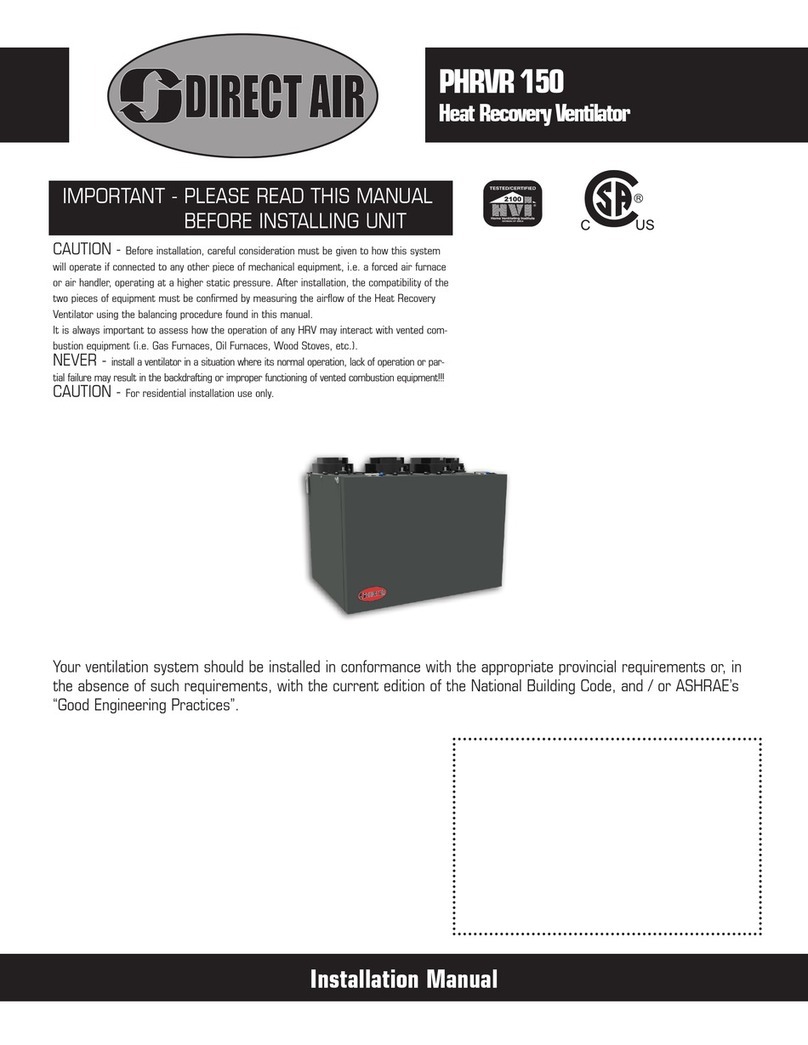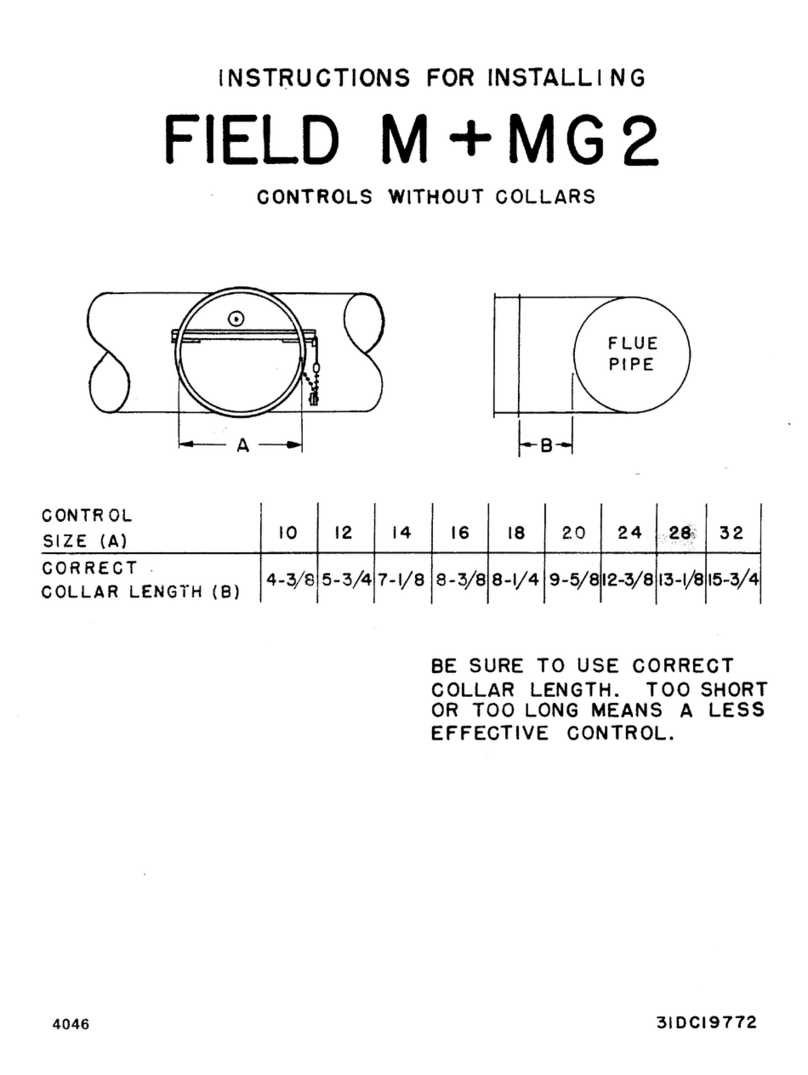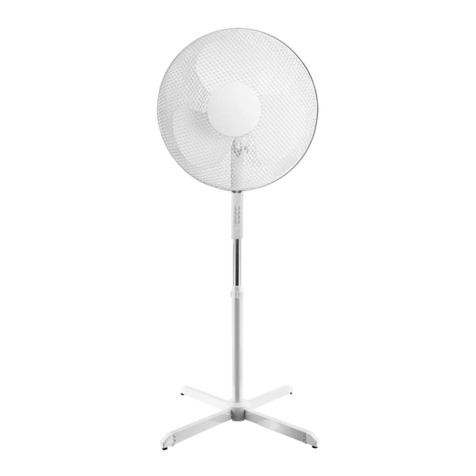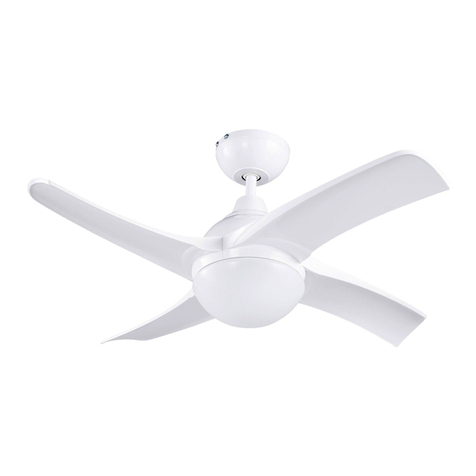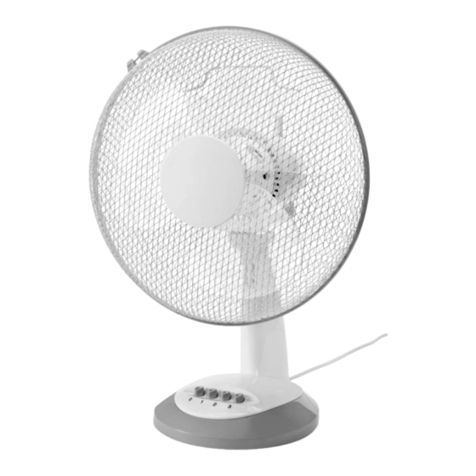Direct Air PHRV 140 User manual

IMPORTANT - PLEASE READ THIS MANUAL
BEFORE INSTALLING UNIT
CAUTION - Before installation, careful consideration must be given to how this system
will operate if connected to any other piece of mechanical equipment, i.e. a forced air furnace
or air handler, operating at a higher static. After installation, the compatibility of the two piec-
es of equipment must be confirmed by measuring the airflow’s of the Heat Recovery
Ventilators by using the balancing procedure found in this manual.
It is always important to assess how the operation of any HRV may interact with vented com-
bustion equipment (i.e. Gas Furnaces, Oil Furnaces, Wood Stoves, etc.).
NEVER - install a ventilator in a situation where its normal operation, lack of operation or par-
tial failure may result in the backdrafting or improper functioning of vented combustion equipment!!!
PHRV(R) Series
Heat Recovery Ventilator
PHRV 140
PHRV 150
PHRV 200
PHRVR 155
PHRVR 160
PHRVR 205
PHRVR 210
PHRVR 305
INSTALLATION, OPERATION AND MAINTENANCE MANUAL

2
TABLE OF CONTENTS
TECHNICAL DATA
PHRVR 160 & PHRVR 210................................................................................ .3
PHRV 150 & PHRV 200 .................................................................................... 5
PHRVR 305 .................................................................................................... 7
PHRV 140, PHRVR 155 & PHRVR 205............................................................... 9
OPERATION............................................................................................................11
Modes Of Operation ........................................................................................11
Optional Remote Controls ............................................................................... 12
Intellitek Multi-Function Controls EDF5 ...............................................................12
INSTALLATION........................................................................................................13
Mounting the Unit ......................................................................................... 13
Location & Ducting ......................................................................................... 14
Examples ....................................................................................................... 17
Air Flow Balancing ......................................................................................... 21
MAINTENANCE ..................................................................................................... 23
TROUBLESHOOTING............................................................................................... 24
ELECTRICAL CONNECTIONS ............................................................................. ... 25
The Best
Limited Warranty
in the Business
• The heat recovery polypropylene core has
a limited lifetime warranty.
• The motors found in all Powrmatic HRV’s
require no lubrication, and are factory
balanced to prevent vibration and promote
silent operation.
• The limited warranty covers normal use.
It does not apply to any defects,
malfunctions or failures as a result of
improper installation, abuse, mishandling,
misapplication, fortuitous occurrence or
any other circumstances outside
Powrmatic’s control.
• Inappropriate installation or
maintenance may result in the
cancellation of the warranty.
• Any unauthorized work will result in
the cancellation of the warranty.
• Powrmatic is not responsible for any
incidental or consequential damages
incurred in the use of the ventilation system.
• Powrmatic is not responsible for providing
an authorized service centre near the
purchaser or in the general area.
• Powrmatic reserves the right to supply
refurbished parts as replacements.
• Transportation, removal and installation
fees are the responsibility of the purchaser.
• The purchaser is responsible to adhering
to all codes in effect in his area.
• The warranty is limited to 5 years on
parts and 7 years on the motor from the
date of purchase, including parts replaced
during this time period. If there is no
proof of purchase available, the date
associated with the serial number will be
used for the beginning of the warranty
period.
* This warranty is the exclusive and only
warranty in effect relative to the ventilation
system and all other warranties either
expressed or implied are invalid.
Sizing (Example) for maximum airflow normally required.
HRVs are typically sized to ventilate the whole house at a minimum of 0.35 air changes per
hour. To calculate, simply take the square footage of the house (including basement) and multi-
ply by the height of the ceiling to get cubic volume. Then, divide by 60 and multiply by 0.35.
Example: SQFT of House 1100
Basement 1100
Total SQFT 2200
Height of ceiling x 8
Cubic volume 17600
/ 60
Maximum airflow required (CFM) 293
x 0.35
103
* Always consult your local code for sizing requirements in your area.
Room classification Number of rooms CFM (L/s) CFM Required
Master bedroom x 20 cfm (10 l/s) =
Basement yes or no =
Bedrooms x 10 cfm (5 l/s) =
Living room x 10 cfm (5 l/s) =
Others x 10 cfm (5 l/s) =
Kitchen x 10 cfm (5 l/s) =
Bathroom x 10 cfm (5 l/s) =
Laundry room x 10 cfm (5 l/s) =
Utility room x 10 cfm (5 l/s) =
Total Ventilation Requirements (add last column ) =
Alternate Method
if yes add 20 cfm / 10 l/s
if no = 0
1 cfm = 0.47189 l/s
1 l/s = 3.6 m3/hr
***Illustrations &
images in this
manual may not be
exactly like unit
purchase, these
illustrations & imag-
es are for examples
only.***

3
PHRVR Series
PHRVR 160 & PHRVR 210
Introducing the NEW PHRVR series of Heat Recovery
Ventilators (HRV) by Powrmatic. Incoming fresh outdoor air
is filtered before it is heated by the stale outgoing air
through a polypropylene heat recovery core. The HRV then
distributes the preheated fresh filtered air throughout the
home by direct ductwork installed specifically for the HRV or
through the ductwork of a forced-air system.
FEATURES:
• Compact Design
• Electrostatic Filters (washable)
• Airflow Balancing Using Powrmatic's Easy "TRUE" Motor
Adjustment
• External Screw Type Dry Contacts For Push Button
Timers (RTS 2), Dehumidistat 1, Dehumidistat 2
& 5MR Intellitek control.
• Easy Core Guide Channels For Removing Core
• Better Packaging For More Protection In Shipping
OPTIONAL CONTROLS
• 5MR – Digital Multi-Function Control
• DEH. 2 – Mechanical Low Voltage Dehumidistat with
On/Off Switch
• DEH. 1 – Mechanical Low Voltage Dehumidistat
• RTS 2 – 15 Minute Push Button Timer
• AQS 1 – Air Quality Sensor
External screw type dry contacts (provided)
SPECIFICATIONS
CASE 22 gauge galvanized steel on the PHRV 210 & 24
gauge galvanized steel on the PHRVR 160. Baked powder
coated paint, grey. Insulated with 1" (25 mm) high density
polystyrene foam to prevent condensation and meet the
requirements of the Underwriters Laboratories 94HB.
MOTORS Two (2) German-manufactured, factory-balanced
ebm™ motors with backward curved blades. Motors come
with permanently lubricated sealed bearings guarantee long
life and maintenance-free operation. Seven (7) year warranty.
CORE A polypropylene heat recovery core configured for an
efficient cross-flow ventilation. Core is 9" x 9" (229 x 229
mm) with a 15" (380 mm) depth {PHRVR 160} or 12" x 12"
(305 x 305 mm) with a 15" (380 mm) depth {PHRVR 210}.
Cores are manufactured to withstand extreme temperature
variations.
FILTERS Two (2) Washable Electrostatic Panel Type Air Filters,
PHRVR 160 is 8.5" (216mm) x 15" (380mm) x 0.125"
(3mm), PHRVR 210 is 11.75" (298mm) x 15" (380mm) x
0.125" (3mm).
CONTROLS External three (3) position (Low/Stand By/
Medium) rocker switch that will offer continuous ventilation.
Powrmatic offers a variety of external controls.
(see optional controls)
DEFROST A preset 5 minute defrost sequence is activated at
an outdoor air temperature of 23ÞF (-5ÞC) and lower.
During the defrost sequence, its mechanism uses a
motorized damper to temporarily block the incoming fresh
air stream allowing the warm air from the home to circulate
through the HRV. The exhaust blower shuts down & the
supply blower switches into high speed to maximize the
effectiveness of the defrost strategy.
The unit then returns to normal operation for 25 minutes,
and continues cycle.
SERVICEABILITY Core, filters, motors and drain pan can be
easily serviced through latched access door. Core
conveniently slides out with ease on an improved railing
system. Electrical box, placed on the outside of the unit,
can also be easily accessed.
Powrmatic, reserves the right to modify, at any time and without notice, any or all of its products’ features, designs, components and specifications to maintain their technological leadership position.

4
Dimensions
AB C D
E
5
TH
port for recirculation defrost type models only
0
0.2
0.4
0.6
0.8
1
1.2
0
50
100
150
200
250
300
400 80
SHR(D) 1505R
SHR(D) 2005R
120 160
Airflow (cfm)
Airflow (L/s)
Static Pressure (in WC)
Static Pressure (Pa)
200 240
190 38 57 76 94 114
Fresh Air
From Outside
Stale Air
To Outside
Fresh Air
To Inside
Stale Air
From Inside
5
TH
port for recirculation defrost models
only can be ducted or left open
Airflow
PHRVR 160 & PHRVR 210 Series HRV
Model A B C D E
PHRVR 160 2 1/4" (56mm) 23 1/2" (596mm) 2 5/8" (67mm) 17 3/8" (441mm) 17 3/8" (441mm)
PHRVR 210 2 1/4" (56mm) 27 7/8" (707mm) 2 5/8" (67mm) 17 3/8" (441mm) 20 1/2" (520mm)
Fan Performance
Performance Data
Model
PHRVR 160 72 % 69 %
PHRVR 210 71 % 76 %
Apparent Sensible
Effectiveness at
32ºF (0ºC)
Apparent Sensible
Effectiveness at
-13ºF (-25ºC)
AIRFLOW CAP. cfm (L/s) @ 0.4 on High Speed
Power
• Volts 120 VAC
• Amperage
PHRVR 160 1.5 Amps Total
PHRVR 210 1.9 Amps Total
• Phase Single Phase
6"
PHRVR 210
PHRVR 160

5
PHRV Series
PHRV 150 & PHRV 200
Introducing the NEW PHRV series of Heat Recovery
Ventilators (HRV) by Powrmatic. Incoming fresh outdoor air
is filtered before it is heated by the stale outgoing air
through a polypropylene heat recovery core. The HRV then
distributes the preheated fresh filtered air throughout the
home by direct ductwork installed specifically for the HRV or
through the ductwork of a forced-air system.
FEATURES:
• Compact Design
• Electrostatic Filters (washable)
• Balancing Dampers Included In Installation Kit
(not factory installed)
• External Screw Type Dry Contacts For Push Button
Timers (RTS 2), Dehumidistats 1, Dehumidistat 2
& 5MR Intellitek control.
• Easy Core Guide Channels For Removing Core
• Better Packaging For More Protection In Shipping
OPTIONAL CONTROLS
• 5MR – Digital Multi-Function Control
• DEH. 2 – Mechanical Low Voltage Dehumidistat with
On/Off Switch
• DEH. 1 – Mechanical Low Voltage Dehumidistat
• RTS 2 – 15 Minute Push Button Timer
• AQS 1 – Air Quality Sensor
External screw type dry contacts (provided)
SPECIFICATIONS
CASE 22 gauge galvanized steel on the PHRV 200 & 24
gauge galvanized steel on the PHRV 150. Baked powder
coated paint, grey. Insulated with 1" (25 mm) high density
polystyrene foam to prevent condensation and meet the
requirements of the Underwriters Laboratories 94HB.
MOTORS Two (2) German-manufactured, factory-balanced
ebm™ motors with backward curved blades. Motors come
with permanently lubricated sealed bearings guarantee long
life and maintenance-free operation. Seven (7) year warranty.
CORE A polypropylene heat recovery core configured for an
efficient cross-flow ventilation. Core is 9" x 9" (229 x 229 mm)
with a 15" (380 mm) depth (PHRV 150) or 12" x 12" (305 x
305 mm) with a 15" (380 mm) depth (PHRV 200). Cores are
manufactured to withstand extreme temperature variations.
FILTERS Two (2) Washable Electrostatic Panel Type Air Filters,
PHRV 150 is 8.5" (216mm) x 15" (380mm) x 0.125"
(3mm), PHRV 200 is 11.75" (298mm) x 15" (380mm) x
0.125" (3mm).
CONTROLS External three (3) position (Low/Stand By/
Medium) rocker switch that will offer continuous ventilation.
Powrmatic offers a variety of external controls. (see optional
controls)
DEFROST A preset 5 minute defrost sequence is activated at
an outdoor air temperature of 23ÞF (-5ÞC) and lower.
During the defrost sequence, the supply blower shuts down
& the exhaust blower switches into high speed to maximize
the effectiveness of the defrost strategy.
The unit then returns to normal operation for 25 minutes,
and continues cycle.
SERVICEABILITY Core, filters, motors and drain pan can be
easily serviced through latched access door. Core
conveniently slides out with ease on an improved railing
system. Electrical box, placed on the outside of the unit, can
also be easily accessed.
Powrmatic, reserves the right to modify, at any time and without notice, any or all of its products’ features, designs, components and specifications to maintain their technological leadership position.

6
Dimensions
AB C D
E
0
0.2
0.4
0.6
0.8
1
1.2
0
50
100
150
200
250
300
400 80
SHR 1504
SHR 2004
120 160
Airflow (cfm)
Airflow (L/s)
Static Pressure (in WC)
Static Pressure (Pa)
200 240
190 38 57 76 94 114
Fresh Air
From Outside
Stale Air
To Outside
Fresh Air
To Inside
Stale Air
From Inside
Airflow
PHRV 150 & PHRV 200 Series HRV
Model A B C D E
PHRV 150 2 1/4" (56mm) 23 1/2" (596mm) 2 5/8" (67mm) 17 3/8" (441mm) 16 1/8" (413mm)
PHRV 200 2 1/4" (56mm) 27 7/8" (707mm) 2 5/8" (67mm) 17 3/8" (441mm) 20 1/2" (520mm)
Fan Performance Performance Data
6"
Model
PHRV 150 72 % 69 %
PHRV 200 71 % 76%
Apparent Sensible
Effectiveness at
32ºF (0ºC)
Apparent Sensible
Effectiveness at
-13ºF (-25ºC)
AIRFLOW CAP. cfm (L/s) @ 0.4 on High Speed
Power
• Volts 120 VAC
• Amperage
PHRV 150 1.5 Amps Total
PHRV 200 1.9 Amps Total
• Phase Single Phase
PHRV 200
PHRV 150

7
PHRVR 305
Introducing the PHRVR 305 series of Heat Recovery
Ventilators (HRV) by Powrmatic. As with previous designs,
incoming fresh outdoor air is filtered before it is heated by
the stale outgoing air. The HRV then distributes the
preheated fresh filtered air throughout the home by direct
ductwork installed specifically for the HRV or through the
ductwork of a forced-air system.
NEW FEATURES:
• Balancing Dampers Included In Installation Kit
(not factory installed)
• Electrostatic Filters (washable)
• External Screw Type Dry Contacts For Push Button
Timers (RTS 2), Dehumidistats 1, Dehumidistat 2
& 5MR Intellitek control
OPTIONAL CONTROLS
• 5MR – Digital Multi-Function Control
• DEH. 2 – Mechanical Low Voltage Dehumidistat with
On/Off Switch
• DEH. 1 – Mechanical Low Voltage Dehumidistat
• RTS 2 – 15 Minute Push Button Timer
• AQS 1 – Air Quality Sensor
External screw type dry contacts (provided)
SPECIFICATIONS
CASE 22 gauge galvanized steel. Baked powder coated paint,
grey. Insulated with 1" (25 mm) high density polystyrene
foam to prevent condensation and meet the requirements of
the Underwriters Laboratories 94HB.
MOTORS Two (2) German-manufactured, factory-balanced
ebm™ motors with backward curved blades. Motors come
with permanently lubricated sealed bearings guarantee long
life and maintenance-free operation. Seven (7) year warranty.
CORES Two (2) polypropylene heat recovery cores configured
for an efficient cross-flow ventilation. Core is 12" x 12" (305
x 305 mm) with a 15" (380 mm) depth. Cores are
manufactured to withstand extreme temperature variations.
FILTERS Two (2) synthetic high quality filters for better indoor
air quality and clean air.
CONTROLS External three (3) position (Low/Stand By/
Medium) rocker switch that will offer continuous ventilation.
Powrmatic offers a variety of external controls.
(see optional controls)
DEFROST A preset 5 minute defrost sequence is activated at
an outdoor air temperature of 23ÞF (-5ÞC) and lower.
During the PHRVR 305 defrost sequence, its mechanism
uses a motorized damper to temporarily block the incoming
fresh air stream allowing the warm air from the home to
circulate through the HRV. The exhaust blower shuts down &
the supply blower switches into high speed to maximize the
effectiveness of the defrost strategy.
The unit then returns to normal operation for 25 minutes,
and continues cycle.
SERVICEABILITY Core, filters, motors and drain pan can be
easily serviced through latched access door.
Powrmatic, reserves the right to modify, at any time and without notice, any or all of its products’ features, designs, components and specifications to maintain their technological leadership position.

8
Dimensions
22.20"
564mm
17.36"
441mm
2.20"
56mm
2.20"
56mm
50.87"
1292mm
5
TH
port for recirculation defrost
type models only
0
0.2
0.4
0.6
0.8
1
1.2
0.00
50.00
100.00
150.00
200.00
250.00
300.00
40.000.00 80.00
SHR3005R
120.00 160.00
Airflow (cfm)
Airflow (L/s)
Static Pressure (in WC)
Static Pressure (Pa)
200.00 240.00 280.00 320.00 360.00
19.000.00 38.00 57.00 76.00 94.00 114.00 123.00 142.00 162.00
5TH port for recirculation defrost models
only, can be ducted or left open
Airflow
PHRVR 305 Series HRV
Performance Data
Model
PHRVR 305 92 % 91 %
Apparent Sensible
Effectiveness at
32ºF (0ºC)
Apparent Sensible
Effectiveness at
-13ºF (-25ºC)
AIRFLOW CAP. cfm (L/s) @ 0.4 on High Speed
Power
• Volts 120 VAC
• Amperage 2.7 Amps Total
• Phase Single Phase
Fan Performance
6"
PHRVR 305

9
PHRV(R) Series
PHRV 140, PHRVR 155 & PHRVR 205
Introducing the PHRV(R) series of Heat Recovery Ventilators
(HRV) by Powrmatic. Incoming fresh outdoor air is filtered
before it is heated by the stale outgoing air through a
polypropylene heat recovery core. The HRV then distributes
the preheated fresh filtered air throughout the home by
direct ductwork installed specifically for the HRV or through
the ductwork of a forced-air system.
FEATURES:
• Compact Design
• Airflow Balancing Using Fantech's Easy "TRUE" Motor
Adjustment for models PHRVR 155 & PHRVR 205
• Electrostatic Filters (washable)
• Balancing Dampers Included In Installation Kit
(not factory installed)
• External Screw Type Dry Contacts For Push Button
Timers (RTS 2), Dehumidistats 1, Dehumidistat 2
& 5MR Intellitek control.
OPTIONAL CONTROLS
• 5MR – Digital Multi-Function Control
• DEH. 2 – Mechanical Low Voltage Dehumidistat with
On/Off Switch
• DEH. 1 – Mechanical Low Voltage Dehumidistat
• RTS 2 – 15 Minute Push Button Timer
• AQS 1 – Air Quality Sensor
External screw type dry contacts (provided)
SPECIFICATIONS
CASE 22 gauge galvanized steel. Baked powder coated paint,
grey. Insulated with 1" (25 mm) high density polystyrene
foam to prevent condensation and meet the requirements of
the Underwriters Laboratories 94HB.
MOTORS Two (2) German-manufactured, factory-balanced
ebm™ motors with backward curved blades. Motors come
with permanently lubricated sealed bearings guarantee long
life and maintenance-free operation. Seven (7) year warranty.
CORE A polypropylene heat recovery core configured for an
efficient cross-flow ventilation. Core is 9" x 9" (229 x 229
mm) with a 15" (380 mm) depth (PHRV 140 & PHRVR
155) or 12" x 12" (305 x 305 mm) with a 15" (380 mm)
depth (PHRVR 205). Cores are manufactured to withstand
extreme temperature variations.
FILTERS Two (2) Washable Electrostatic Panel Type Air Filters,
PHRV 140 & PHRVR 155 is 8.5" (216mm) x 15" (380mm) x
0.125" (3mm), PHRVR 205 is 11.75" (298mm) x 15"
(380mm) x 0.125" (3mm).
CONTROLS External three (3) position (Low/Stand By/
Medium) rocker switch that will offer continuous ventilation.
Powrmatic offers a variety of external controls to
compliment its units and allows you to appreciate its
functions to the fullest. (see optional controls)
DEFROST A preset 5 minute defrost sequence is activated at
an outdoor air temperature of 23ÞF (-5ÞC) and lower.
During the PHRV 140 defrost sequence, the supply blower
shuts down & the exhaust blower switches into high speed
to maximize the effectiveness of the defrost strategy.
During the PHRVR Series (PHRVR 155 & PHRVR 205)
defrost sequence, its mechanism uses a motorized damper
to temporarily block the incoming fresh air stream allowing
the warm air from the home to circulate through the HRV.
The exhaust blower shuts down & the supply blower
switches into high speed to maximize the effectiveness of
the defrost strategy.
The unit then returns to normal operation for 25 minutes,
and continues cycle.
SERVICEABILITY Core, filters, motors and drain pan can be
easily serviced through latched access door.
Powrmatic, reserves the right to modify, at any time and without notice, any or all of its products’ features, designs, components and specifications to maintain their technological leadership position.

10
Dimensions
A B
C
D
VHR1404/
VHR1405R
0
0.2
0.4
0.6
0.8
1
1.2
0.00
50.00
100.00
150.00
200.00
250.00
300.00
40.000.00 80.00 120.00 160.00
Airflow (cfm)
Airflow (L/s)
Static Pressure (in WC)
Static Pressure (Pa)
200.00 240.00
19.000.00 38.00 57.00 76.00 94.00 114.00
VHR2004
VHR2005R
Optional recirculation
duct collar (provided)
with VHR 1405R
& VHR 2005R only
Airflow
PHRV 140, PHRVR 155 & PHRVR 205 Series HRV
Model A B C D
PHRV 140 23 3/4" (604mm) 17 1/4" (438mm) 16 1/4" (413mm) 2 1/4" (56mm)
PHRVR 155 23 3/4" (604mm) 17 1/4" (438mm) 16 1/4" (413mm) 2 1/4" (56mm)
PHRVR 205 28" (711mm) 17 1/4" (438mm) 20 1/2" (521mm) 2 1/4" (56mm)
Fan Performance Performance Data
Model
PHRV 140 81 % 79 %
PHRVR 155 81 % 79 %
PHRVR 205 71 % 76 %
Apparent Sensible
Effectiveness at
32ºF (0ºC)
Apparent Sensible
Effectiveness at
-13ºF (-25ºC)
AIRFLOW CAP. cfm (L/s) @ 0.4 on High Speed
* All collars on the
Series have a
diameter of 6".
Power
• Volts 120VAC
• Amperage 0.8 - 1.6 A
• Phase Single
PHRV 140 &
PHRVR 155
PHRVR 205
Optional recirculation
duct collar (provided)
with PHRVR 155 &
PHRVR 205

11
OPERATION
Winter:
Humidity control is very important during the winter months.
This is when problems will be most apparent since condensa-
tion on the windows will often occur. The colder the outside
temperature, the greater the risk of condensation in the
home. The average relative humidity should be maintained
between (30-60) to avoid condensation. Low speed continu-
ous ventilation with high speed override is recommended.
A Heat Recovery Ventilator (HRV) is designed to bring fresh air into a building while exhausting an equal amount of stale air. During the winter months,
the incoming cold fresh air is warmed by utilizing the heat recovered from the stale air before it is exhausted to the outdoors. During summer months
when the indoor space is air conditioned, the HRV will help in cooling the incoming fresh air with the stale air that is being exhausted.
Powrmatic HRV’s are designed to run continuous or on intermittent, giving the homeowner complete control over their air quality. Continuous low
speed ventilation is recommended, which will help eliminate carbon dioxide, voc’s and other gases as well as freshen up the home. Intermittent high
speed ventilation can be obtained through a variety of optional remote controls found in this manual. Below are some examples of seasonal operation
of an HRV.
Spring:
Temperatures are more moderate and become
warmer each day. To keep the humidity and tem-
perature uniform, set the dehumidistat higher (if
installed). You may also switch the HRV to standby
mode if desired.
Summer:
The air is sometimes hot and humid. To stop the warm
humid air from entering, set the dehumidistat at its high-
est level. If the Intellitek series controller is installed, the
air exchanger can be set to cycle the unit on and off as
desired from that wall control. However, continuous ven-
tilation is recommended.
Fall:
Rain and rapid temperature changes make it difficult
to control the internal humidity level and may result
in condensation on the windows. A remote dehu-
midistat may help give greater control over the
inside environment.
The entire line of PHRV & PHRVR series Heat Recovery Ventilators comes equipped with Powrmatic's new electronic uni-control board which offers
a wide variety of features making it the ultimate ventilation control system. Powrmatic engineers have used the latest technology to provide solid,
trouble free operation under any conditions.
The Powrmatic uni-control board offers stand alone operating capabilities as well as an exclusive 2 wire communication to most external controls.
The trouble-free optional controls include: two different rotary dial dehumidistats, an air quality sensor (3 wire communication required), a 15 minute
remote push-button timer, as well as the most sophisticated line of remote wall mounted controls, the Intellitek 5MR.
An on-board diagnostic LED helps find problems quickly and efficiently. For example the LED can be used to signal a broken or shorted electronic
wall control wire. Electronic air temperature probe gives this board accurate readings in order to minimize unnecessary defrost operation, and the
on-board jumpers provide the user with the option of adjusting defrost time and sequence to optimize performance under abnormal conditions. The
defrost operation is automatic and is usually never adjusted.
4. Defrost (PHRV Models)
The automatic defrost cycle PHRV
models of HRVs consists of a fan
shutdown. When the supply air
stream temperature goes below
-5°C (23°F), the supply motor
shuts down and the exhaust motor goes into high speed. Ambient air
is passed through the unit for a period of 5 minutes. The supply motor
will then re-start and run at the preset speed. The exhaust motor will
also slow down to the preset speed, and the unit will operate in the run
cycle for 25 minutes. This fan shutdown defrost cycle continues until
the supply air stream rises above 0°C (32°F).
MODES OF OPERATION
1. Continuous / Ventilation Mode
In this mode of operation both fans
are operating and exchanging air with
the outside. The heat recovery ventila-
tor (HRV) constantly exchanges the
air at the rate you select, either at low
or medium speed, and switches to high speed when activated by an
optional remote control. The "Low" and "Med" fan speed selection will cause
the unit to operate in continuous exchange mode at an exchange rate of
35% and 50% maximum airflow rating respectively. Continuous mode is
recommended, since pollutants are slowly but constantly being generated
in your house.
Air from
House
Air from
Outside
Air to
House
Air to
Outside
2. Intermittent / Standby Mode
The system is always on standby and operates
at high speed when activated by an optional
remote control. "Standby" should be selected if
the user wishes to stop the unit from continuous
exchange. We recommend that the "Standby"
mode only be used if your system is equipped with an optional external
control, in which case, the unit would activate to "High" fan speed, until
the control is satisfied and then return to standby (off).
* no exchange of air
3.Defrost/Recirculation Mode
(PHRVR Models)
The automatic defrost cycle PHRVR mod-
els of HRV consists of a damper defrost
which allows air to recirculate throughout
the unit & home. When the supply air
stream temperature goes below -5°C (23°F), the exhaust motor shuts down,
the supply motor goes to high speed, and a damper closes the supply, opening
a 5th collar. The ambient air is then recirculated through the unit & home for a
period of 5 minutes. The unit will then resume normal operation for a time
period of 25 minutes. This damper defrost cycle continues until the supply air
stream rises above 0°C (32°F). The recirculation feature can be obtained with
the use of an optional Intellitek EDF5 (5MR) control.
Air to
House
Air from
House
Air from
House
Air to
outside

12
15-min Timer - The 15-minute remote timer is typically installed in areas where
contaminated such as moisture and odors, are produced. Simply push the
button and the HRV will activate to high speed for 15 minutes. Up to 5
electronic timers can be installed throughout the building at a distance of up to
500 feet (152 meters) from the HRV.
Air Quality Sensor - The wall mount Air Quality Sensor (AQS) monitors indoor
air quality and activates the override mode when carbon monoxide, formaldehyde,
benzene, volatile organic compounds and other pollutants are detected. The
unit will then return to normal mode once the air pollutants are reduced to a
pre-determined lower level.
* This control is not a warning device.
Dehumidistat II - The wall mount dehumidistat II offers the same features of the
dehumidistat I plus additional off/on control for the HRV. Dial illuminates when
in override mode.
Dehumidistat I - The wall mount dehumidistat monitors the humidity level in the
area it is installed. When the humidity level rises above the desired set-point,
the HRV will activate to high speed/override mode. Once the humidity level
returns to desired condition, the unit will return to the normal mode.
To avoid window condensation:
• It is not necessary to
change the humidity control
every day. Monitor the
average weekly
temperature or experiment
with various settings until
you find a level that is
comfortable for you. Adjust
the control when needed.
PRACTICAL
TIPS
* All controls are low voltage. 18 to 24
gauge wire is recommended.
OPTIONAL REMOTE CONTROLS
OPERATION (CONT'D)
NOTE:
A dehumidistat is ideal for
use in energy efficient
houses where indoor
humidity (during the
heating season) is higher
than outdoor levels. High
humidity is a major cause
of structure damage and
IAQ problems such as mold
and mildew.
2 wire installation
4 wire installation
3 wire installation
2 wire installation
5MR
INTELLITEK
MULTI-FUNCTION
WALL CONTROL
Control multiple func-
tions of your
Powrmatic HRV with
one slimline wall con-
trol. Two wire connec-
tion simplifies installa-
tion. Use one EDF5 per
PHRVR installed.
OVERRIDE SPEED
CONTROL
Push to select
override speed of
unit.
CYCLE CONTROL
Set unit to cycle on
15, 20, or 30 min-
utes every hour
MODE SPEED
Set Unit to Low,
Medium or High
Speed
OVERRIDE TIMER
When pressed, unit
will provide high
speed ventilation
for one 15,
30 or 60 minute
period.
DIGITAL DISPLAY
Shows Indoor Humidity Level
This control will not read
below 29% RH
DEHUMIDISTAT CONTROL
(see description on top of this page)
MAINTENANCE LIGHT
Light comes on when
it’s time to clean unit.
POWER
On/Off and Reset
MODES
Select Intermittent,
Recirculation or
Continuous
Ventilation Modes
OPTIONAL INTELLITEK CONTROL
NOTE:
When an Intellitek control
is installed, the rocker
switch located on the right
hand side of the HRV will
be automatically
deactivated giving the user
complete control from
wherever he/she wishes to
mount the control pad.
NOTE:
The override speed cannot
be set at a fan speed lower
or equal to the normal
operating fan speed. For
example, if the unit is
normally operating at a
medium fan speed, the
override fan speed will be
automatically set to high.
NOTE:
5MR model, changing the
override speed will change
default override speed for
other external controls.
EXAMPLES:
If on the 5MR control, you
have set the override
control at medium, and
you start an external
remote control (15 min.
timer), the unit will run at
medium speed for 15 min.
PRACTICAL
TIPS
4 1/2"
(114 mm)
5 1/8"
(130 mm)
Width = 4 1/2" (110mm)
Height = 5 1/8" (130mm)
Thickness = 5/8" (15mm)

13
• Install the unit close to
the outside wall on
which the supply and
exhaust hoods will be
mounted.
• Have a nearby power
supply 120 Volts, 60Hz.
• Have the possibility of
mounting the unit to
supporting beams.
• Mount the unit as
level as possible in
order to allow proper
condensate drainage.
• Have access to
a water drain for the
condensate of the unit
during defrost.
• Have a certain amount
of heat around the unit
(attic installation is not
recommended).
• Minimize any noise
level that would be
created by the unit in
the living area.
• Have access for future
maintenance.
2 Install the drain hose,
making a “P” trap
INSTALLATION
PRACTICAL TIPS
3 Hang the unit by
slipping a link onto the
hanging hooks, making
sure the unit is level.
2 Attach a hanging chain
(provided) to each 10 3/4”
(19 mm) bolt (provided) in
the top 4 corners of the
unit and tighten.
1 Place Fastening hooks
on the strapping board
or the floor joists.
1 Install the drain nipple.
Installing Drain Line
Through normal operation and during its defrost mode, the HRV may produce some condensation.
This water should flow into a nearby drain, or be taken away by a condensate pump. The HRV and
all condensate lines must be installed in a space where the temperature is maintained above the
freezing point. A “P” trap should be made in the drain line. This will prevent odors from being
drawn back up into the unit.
MOUNTING
LOCATION
The HRV must be located in a heated space where it will be possible to conveniently service the
unit. Typically the HRV would be located in the mechanical room or an area close to the outside
wall where the weatherhoods will be mounted. If a basement area is not convenient or does not
exist, a utility or laundry room may be used.
Attic installations are not normally recommended due to:
- the complexity of work to install
- freezing conditions in the attic
- difficulty of access for service and cleaning
Connecting appliances to the HRV It is not recommended, including:
- clothes dryer
- range top
- stovetop fan
- central vacuum system
These appliance may cause lint, dust or grease to collect in the HRV , damaging the unit.
NOTE: Connecting any of these type of appliances to the HRV will invalidate your warranty

14
3 Push the hood into
the opening. Attach
the hood to the
outside wall with
mounting screws.
Repeat the installation
procedure for both
the Supply and
Exhaust hood.
2 Pull the insulated
flexible duct through
the opening until it is
well extended and
straight. Slide the
duct’s inner vinyl
sleeve over the hood
collar and secure, pull
the insulation over
the duct and then the
vapor barrier over the
sleeve and secure
with duct tape.
4 Using a caulking
gun, seal around
both hoods to
prevent any
leaks.
1 Using the collar of
the outside hood,
outline the intake &
exhaust holes to be
cut. The holes should
be slightly larger
than the collar to
allow for the
thickness of the
insulated flexible
duct. Cut a hole
for both the intake
and exhaust hoods.
• Decide where your intake and
exhaust hoods will be located.
PRACTICAL
TIPS
INSTALLING DUCTS GOING TO / FROM OUTSIDE
A well designed and installed ducting system will allow the HRV to operate at its maximum efficiency.
Always try to keep duct runs as short and straight as possible.
See Installation Diagrams for installation examples.
INSTALLING THE DUCTING
TO THE WEATHERHOODS
The inner liner of the flexible insulated duct
must be clamped to the sleeve of the weath-
erhoods (as close to the outside as possible)
and to the appropriate port on the HRV. The
insulation should remain full and not be
squished. The outer liner, which acts as a
vapor barrier must be completely sealed to
outer wall and the HRV using tape and or
caulking. A good bead of high quality caulk-
ing (preferably acoustical sealant) will seal
the inner flexible duct to both the HRV port
and the weatherhood prior to clamping.
To minimize air flow restriction, the flexible
insulated duct that connects the two outside
weatherhoods to the HRV should be
stretched tightly and be as short as
possible. Twisting of folding the duct will
severely restrict air flow.
Locating the Intake
Weatherhood
• Should be located upstream
(if there are prevailing winds)
from the exhaust outlet
• At least 6’ (2m) from the
exhaust weatherhood
• At least 6’ (2m) away from
dryer vents and furnace
exhaust ( medium or high effi-
ciency furnaces)
• A minimum of at least 6’ (2m)
from driveways, oil fill pipes,
gas meters, or garbage con-
tainers
• At least 18” (457mm) above
the ground, or above the
depth of expected snow accu-
mulation
• At least 3’ (1m) from the cor-
ner of the building
• Do not locate in a garage,
attic or crawl space
Locating the Exhaust
Weatherhood
• At least 6’ (2m) from the ven-
tilation air intake
• At least 18” (457mm) above
ground or above the depth of
expected snow accumulation
• At least 3’ (1m) away from
the corner of the building
• Not near a gas meter, electric
meter or a walkway where fog
or ice could create a hazard
• Not into a garage, workshop
or other unheated space
When installing the weather-
hood, it’s outside perimeter
must be sealed with exterior
caulking.

15
PRACTICAL TIPS
INSTALLING DUCTS TO / FROM INSIDE
• Building Codes and
Combustion Appliance
Installation Codes do
not allow location of
return air grilles or any
opening such as a
“breathing tee” in an
enclosed room with
spillage susceptible
combustion appliances.
• The fresh air inlet from
the HRV needs to
respect a minimum
distance from the furnace
return drop to ensure
proper air mixing and
temperature at the
furnace core.
See furnace manufacturer
for appropriate
specifications.
Direct Connection
• A direct connection requires that the fan of the furnace
runs continuously. It may be inter-linked electrically
(low voltage) with the HRV (Accessory Control
Contacts) for intermittent demand. Should you wish to
hard duct the supply air directly into the cold air return
of the furnace, remember to check the airflow balance
of the HRV with the furnace fan both “on” and “off” to
determine that it does not imbalance the HRV more
than 10%. Make sure you respect the minimum
distance from the supply air in of the HRV and the
furnace (Refer to your local and National Building &
Heating Codes for any variations in these notes). from HRV
For minimum distance
See local building codes
and practical tips.
To maximize airflow in the ductwork system, all ducts should be kept short and have as few bends or elbows as possible. Forty-five
degree are preferred to 90º elbows. Use “Y” tees instead of 90º elbows whenever possible.
All duct joints must be fastened with screws or duct sealant and wrapped with a quality duct tape to prevent leakage. Aluminum foil
duct tape is recommended. Galvanized ducting from the HRV to the living areas in the house is recommended whenever possible,
although flexible duct can be used in moderation when necessary.
SUPPLY AIR DUCTING
In homes without a forced air furnace, fresh air should be supplied to all habitable rooms including, bedrooms and living areas. It should
be supplied from high wall or ceiling locations. Grilles that diffuse the air comfortably such as Powrmatic grille are recommended.To
avoid possible noise transfer through the ductwork system, a short length (approximately 12”, 300 mm) of nonmetallic flexible insulated
duct should be connected between the HRV and the supply/exhaust ductwork system.
The main supply and return lines to/from the HRV must be 6 inches (150 mm) minimum. Branch lines to the individual rooms may be
as small as 4 inches (100 mm), but 5 inch (125 mm) lines are preferred.If the floor is the only option available, then special care should
be taken in locating grilles. Areas such as under baseboard heaters will help to temper the air. Also optional inline duct heaters are
available for mounting in the supply duct work to add heat if required.In homes with a forced air furnace, you may want to connect the
HRV to the furnace ductwork (see information below).

16
• For new construction,
the rigid ducts are run
in the walls.
• Choose the location for
your Supply and Exhaust
grilles. The Supply
grilles should be located
in every habitable room
and the Exhaust Grilles
should be located in the
wet rooms.
• A piece of flexible
ducting should be
placed between the
Supply Air In and Out
collar of the HRV and
the rigid ducting to
absorb any noise or
vibrations.
• For proper network
of ducting, see TYPES OF
INSTALLATIONS.
• The grilles are to be
installed on the ceiling
or on the wall 6” (152
mm) to 12” (305 mm)
from the ceiling.
4 Push the grille into the optional mounting collar or directly into installed elbow.
INSTALLING DUCTS TO / FROM INSIDE (CONT'D)
PRACTICAL TIPS
2 Working from a closet, attic or inside your joist wall, run the length of
ducting required for the proper grille location and cut a hole in the drywall.
Fasten the mounting collar (optional) to the ducting and fasten the collar
to the wall or ceiling with screws.
3 The grille - airflow can be adjusted by rotating the inside unit. It is
recommended that the grilles be completely opened at first and then
adjusted later as needed.
Dedicated Installation for Existing Home -
(non forced air heating / cooling system)
1 Begin with the duct collar marked “Exhaust Air In”. Slide a short piece
(12”) of flexible duct over the duct collar. Using duct tape, tape the flexible
duct to the collar. Run the flexible ducting to the main rigid duct trunk line,
which connects to the remainder of the ducts going to and from rooms in
the house. Repeat the steps for the “Supply Air Out” on the side of the HRV.
Exhaust Air Ducting
The stale air exhaust system is used to draw air from the points in the house where the worst air quality problems occur. It is recom-
mended that return air ducts be installed in the bathroom, kitchen, and laundry room. Additional return air ducts from strategic
locations (i.e. greenhouse, atrium, swimming pool, sauna, etc.) may be installed. The furnace return duct may be also used to exhaust
from. In this method, the exhaust air is not ducted back from bathrooms, kitchens, etc to the HRV with “dedicated lines”.
This method has become popular and provides good ventilation when installed in accordance with the instructions. The furnace
blower must be running when the HRV is operating for this method to be effective.

17
Bedrooms
Fresh Air
Exhaust Air
Central Control - optional
Fresh air to living room
Exhaust
Bathroom
460 mm
1800 mm
HRV
DUCTING FIFTH PORT UNITS (R)
All PHRVR HRV’s have a fifth duct port on top or side of the unit. This duct port is for both defrost and the recirculation mode. A motorized
damper installed in the port closes during defrost or recirculation temporarily blocking the incoming fresh air-stream, allowing the warm
air from the house to circulate through the HRV. You may wish to duct this port to a common clean air room (living room or dining room)
so when recirculation is activated, household odors from the kitchen, bathroom or basement won’t be introduced into the living spaces
of the home environment.
INSTALLATION EXAMPLES
Example diagram only-duct configuration may change depending on model
It is the responsibility of the installer to ensure all ductwork is sized and installed as designed to ensure the system will perform as
intended. All air movement devices have a performance curve. The amount of air (CFM) that an HRV will deliver is directly related
to the total external static pressure (E.S.P.) of the system. Static pressure is a measure of resistance imposed on the blower by
length of duct work/number of fittings used in duct work, duct heater etc.
Fully Dedicated System
(new construction)
Stale air drawn from key areas
of home (bathroom, kitchen,
laundry)
Fresh air supplied to main liv-
ing areas
HRV must be balanced
RADIANT HEATED HOMES
NOTE:
The recirculation function can be accessed with a optional 5MR intellitek control. It allows air to move gently throughout the home
without exchanging air to the outside, until needed.

18
Bedrooms
Fresh Air
Exhaust Air
Furnace thermostat
Exhaust
Bathroom
460 mm
HRV
Central Control - optional
Return Air
HRV
Connection
1800 mm
INSTALLATION EXAMPLES (CONT'D)
Example diagram only-duct configuration may change depending on model
Partially Dedicated System
Stale air drawn from key areas of
home (bathroom, kitchen, laundry)
Fresh air supplied to main living
areas via the forced air system.
HRV must be balanced
DIRECT CONNECTION of the SUPPLY AIR STREAM to the FURNACE COLD AIR RETURN
(Stale air drawn from key areas of home)
Exhaust Air from various parts of home.
i.e. bathrooms (if required),
kitchens (if required)
NOTES:
1.Furnace blower may be required to operate when HRV is on to provide good air distribution.
2. Weatherhood arrangement is for drawing purposes only. 6’ (2m) minimum separation recommended.
18” (460mm) above grade minimum.
3. Due to the differences in pressure between the HRV and the equipment it is being connected to, the HRV’s airflow must be confirmed
on site, using the balancing procedure found in the installation manual.
* Unit is normally balanced on HIGH speed with furnace blower ON.
Outdoors
Return Air
1 m
(3’-3”) min.
recommended
Cool Air
Return
* Ducts connection may
vary depending on model

19
INSTALLATION EXAMPLES (CONT'D)
DIRECT CONNECTION of both the HRV SUPPLY AIR STREAM and
EXHAUST AIR STREAM to the FURNACE COLD AIR RETURN
Simplified Installation
Option 1
(Return/Return Method)
• HRV must be balanced
• It is mandatory that the furnace blower
run continuously or HRV operation
be interlocked with the furnace blower
• Check local codes/authority having
jurisdiction for acceptance
Note: Option 1 is the pre-
ferred/recommended method
when doing a simplified
installation
NOTES:
1. Furnace blower may be required to operate when ventilation from HRV is required. The furnace should be set to
run continuously or interlocked with HRV.
2. A minimum separation of 39 inches (1m) is recommended between the two direct connections.
3. The exhaust air connection should be upstream of the supply air connection to prevent exhausting any fresh air.
4. Weatherhood arrangement is for drawing purposes only. 6’ (2m) minimum separation recommended. 18” (460
mm) above grade minimum.
5. Due to the differences in pressure between the HRV and the equipment it is being connected to, the HRV’s air-
flow must be confirmed on site, using the balancing procedure found in the installation manual.
* Unit is
normally
balanced
on HIGH
speed
with
furnace
blower
ON.
Return Air
1 m
(3’-3”) min.
recommended
Cool Air
Return
Outdoors
40”
Min.
* Ducts connection may
vary depending on model
Example diagram only-duct configuration may change depending on model

20
INSTALLATION EXAMPLES (CONT'D)
DIRECT CONNECTION of both the HRV SUPPLY AIR STREAM &
EXHAUST AIR STREAM to the FURNACE COLD AIR RETURN & SUPPLY AIR SIDE
Simplified Installation
Option 2
(Supply/Return Method)
• HRV must be balanced
• It is recommended that the furnace blower
run continuously or HRV operation
be interlocked with the furnace blower
• Check local codes /authority having
jurisdiction for acceptance
Note: Option 1 is the pre-
ferred/recommended method
when doing a simplified
installation
NOTES:
1. Furnace blower may be required to operate when ventilation from HRV is required. The furnace should be set to
run continuously or interlocked with HRV.
2. The exhaust air connection should be upstream of the supply air connection to prevent exhausting any fresh air.
3. Weatherhood arrangement is for drawing purposes only. 6 feet (2m) minimum separation recommended.
18 inches (460 mm) above grade minimum.
4. Due to the differences in pressure between the HRV and the equipment it is being connected to, the HRV’s air-
flow must be confirmed on site, using the balancing procedure found in the installation manual.
* Unit is
normally
balanced
on HIGH
speed
with
furnace
blower
ON.
Return Air
1m
(3’-3”) min.
recommended
Cool Air
Return
Outdoors
1 m
(3’-3”) min.
recom-
mended
* Ducts connection may
vary depending on model
Example diagram only-duct configuration may change depending on model
This manual suits for next models
7
Table of contents
Other Direct Air Fan manuals
Popular Fan manuals by other brands
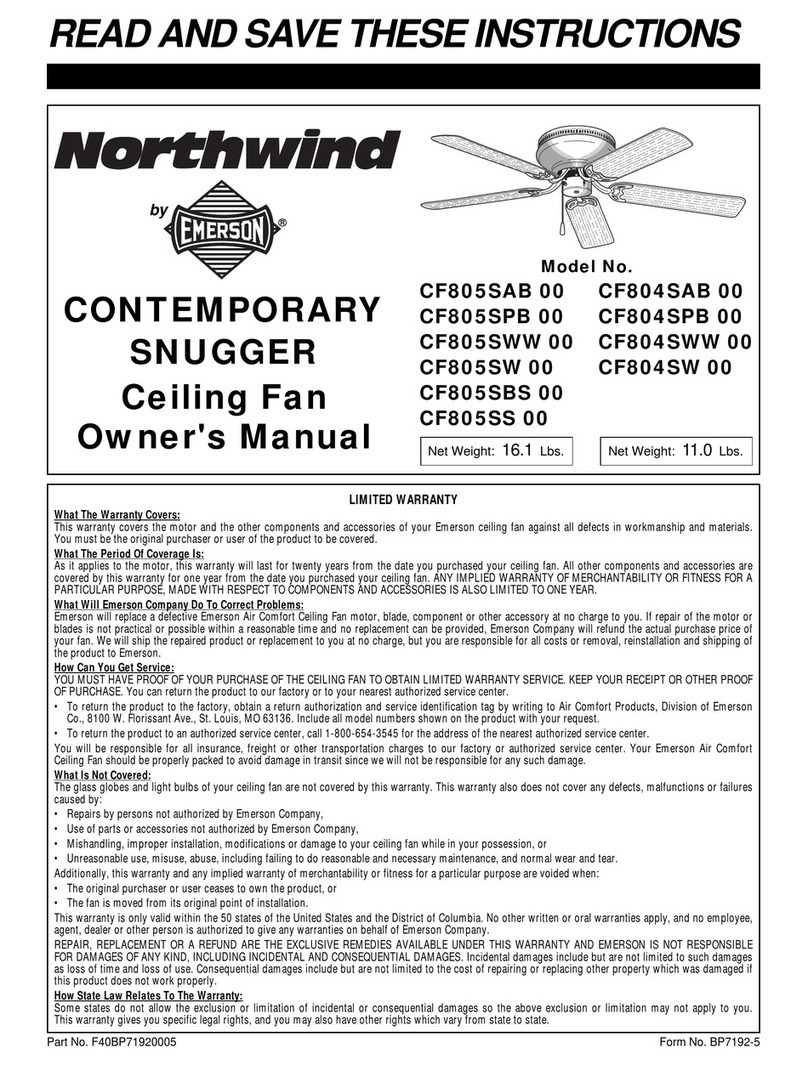
Emerson
Emerson CF804SAB owner's manual
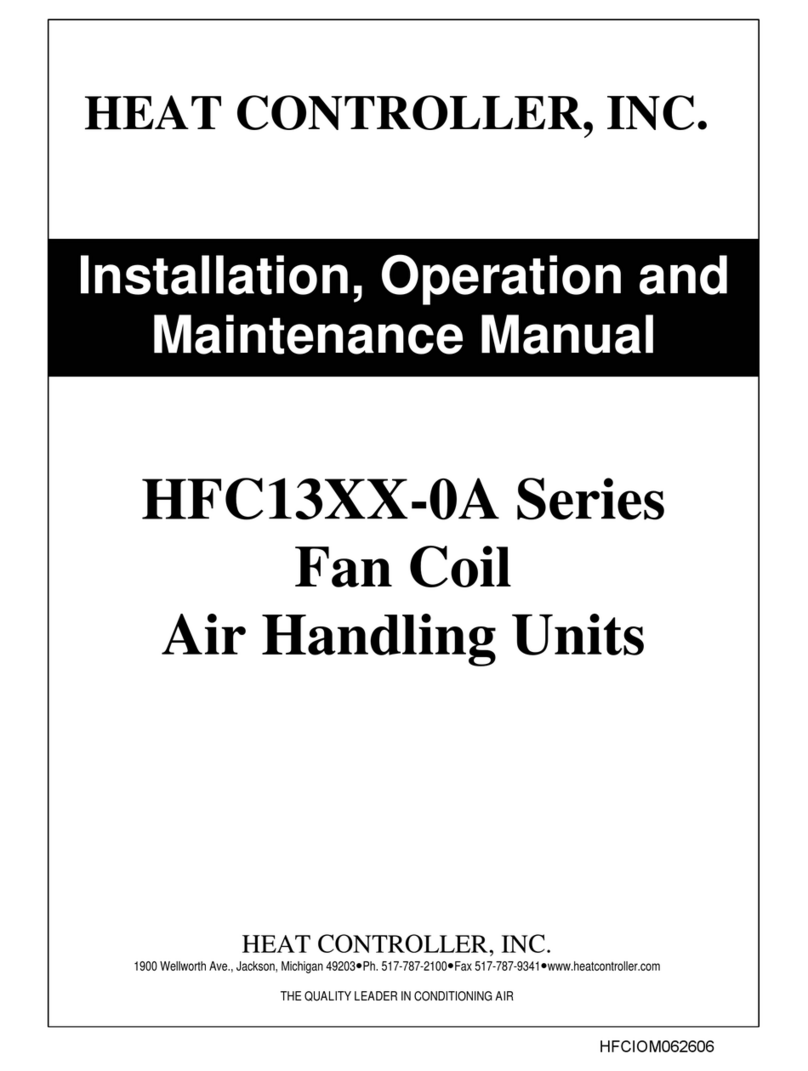
Heat Controller
Heat Controller HFC13XX-0A Series Installation, operation and maintenance manual
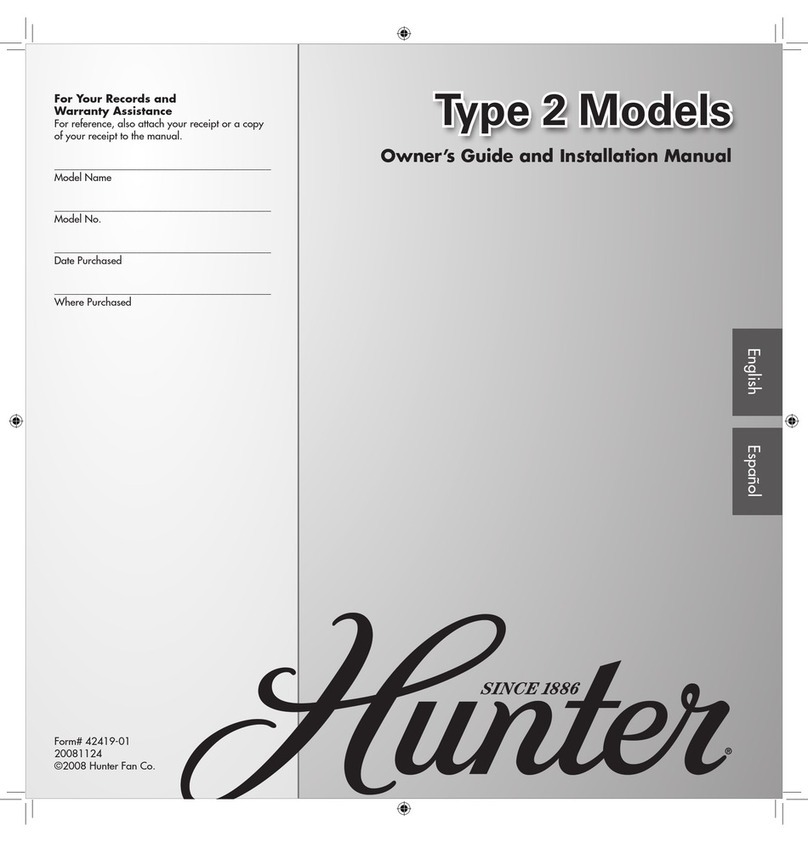
Hunter
Hunter 25745 Owner's guide and installation manual

DOSPEL
DOSPEL BLACK & WHITE installation instructions
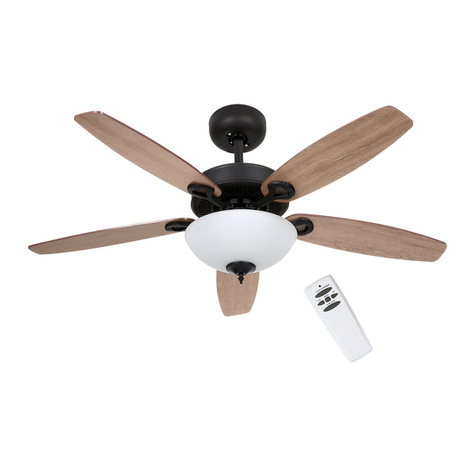
Soltronics
Soltronics LTG-CF5002 Installation instruction
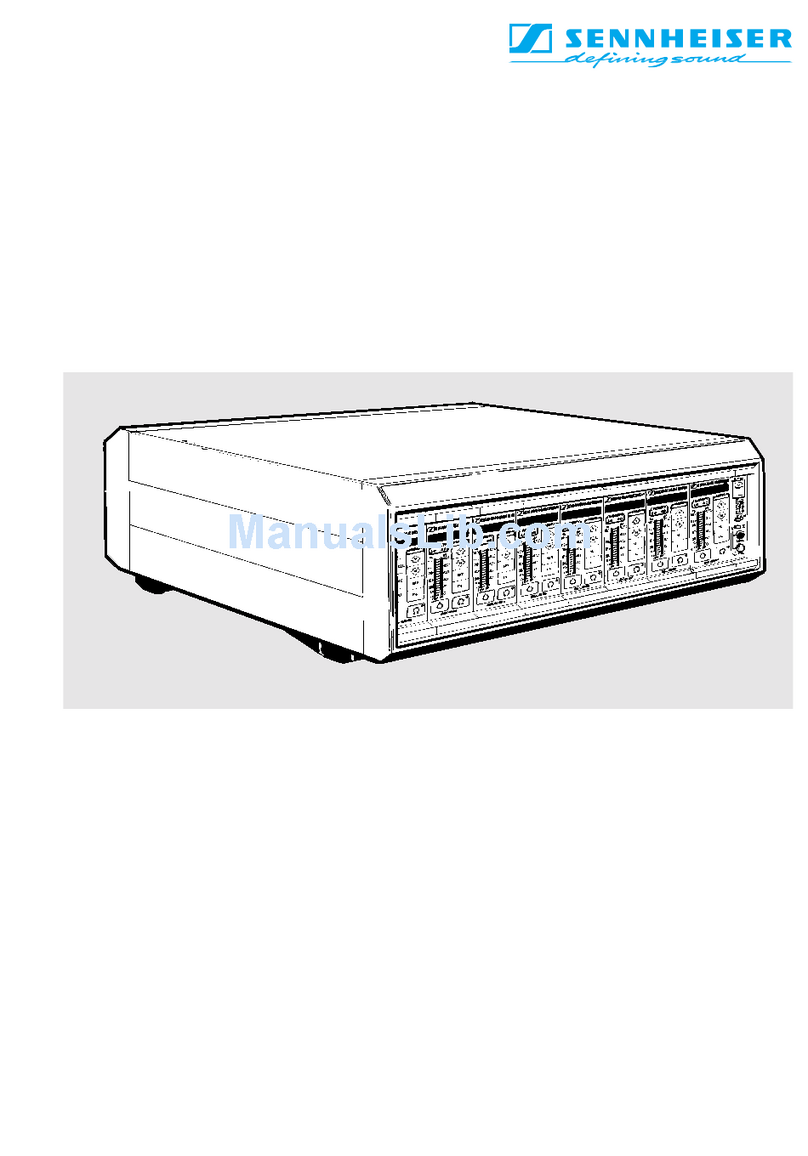
Sennheiser
Sennheiser EM 1046 FA Assembly instructions
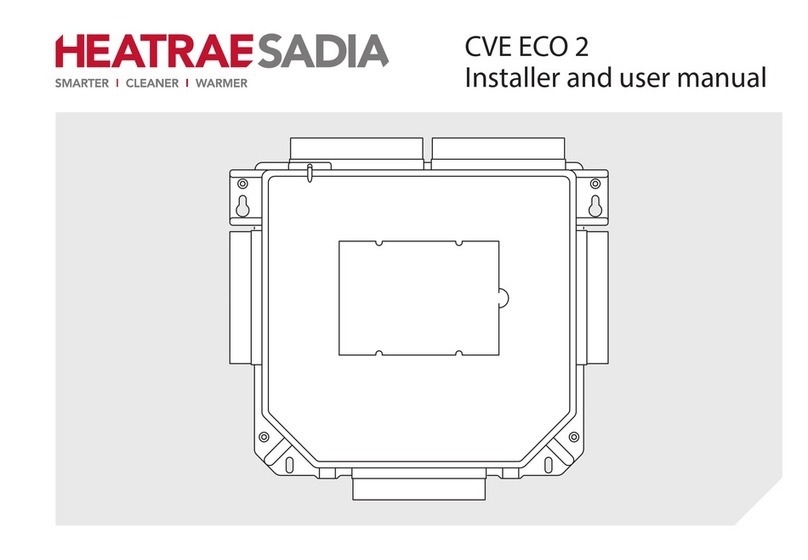
Heatrae Sadia
Heatrae Sadia CVE ECO 2 installer and user manual

NSB FAN
NSB FAN KELLY User manual & installation guide
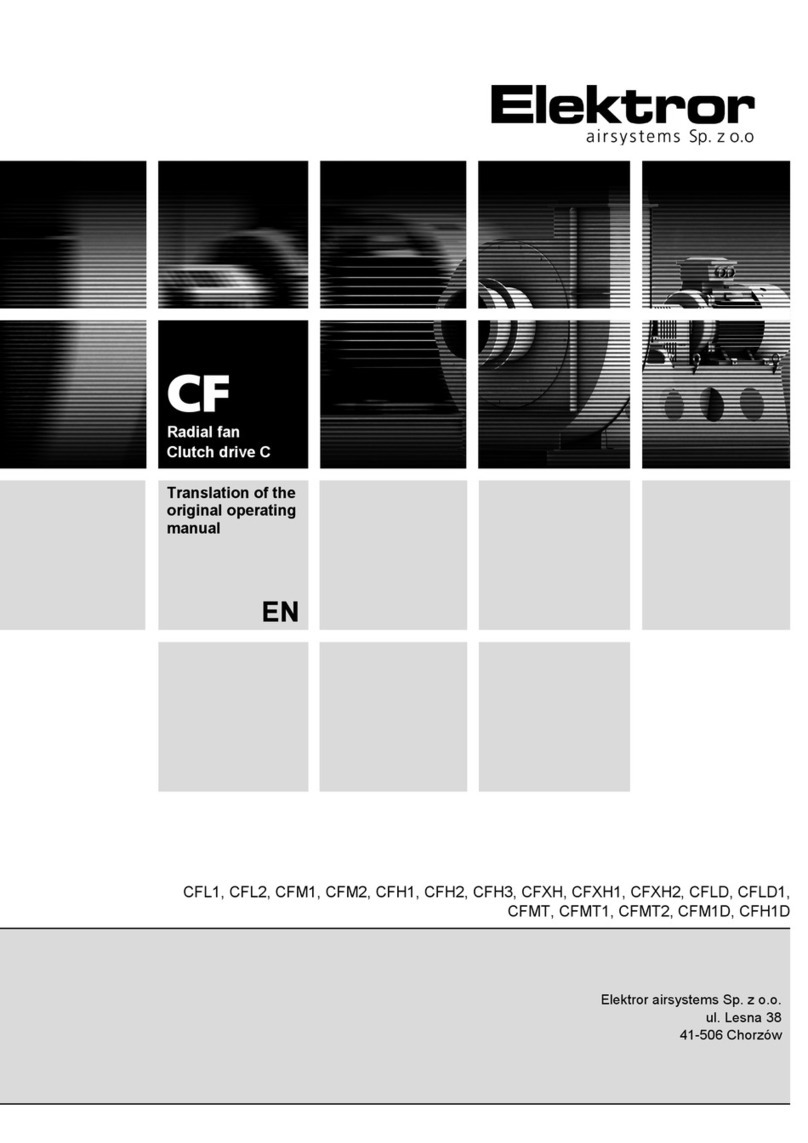
Elektror
Elektror CF Series Translation of the original manual
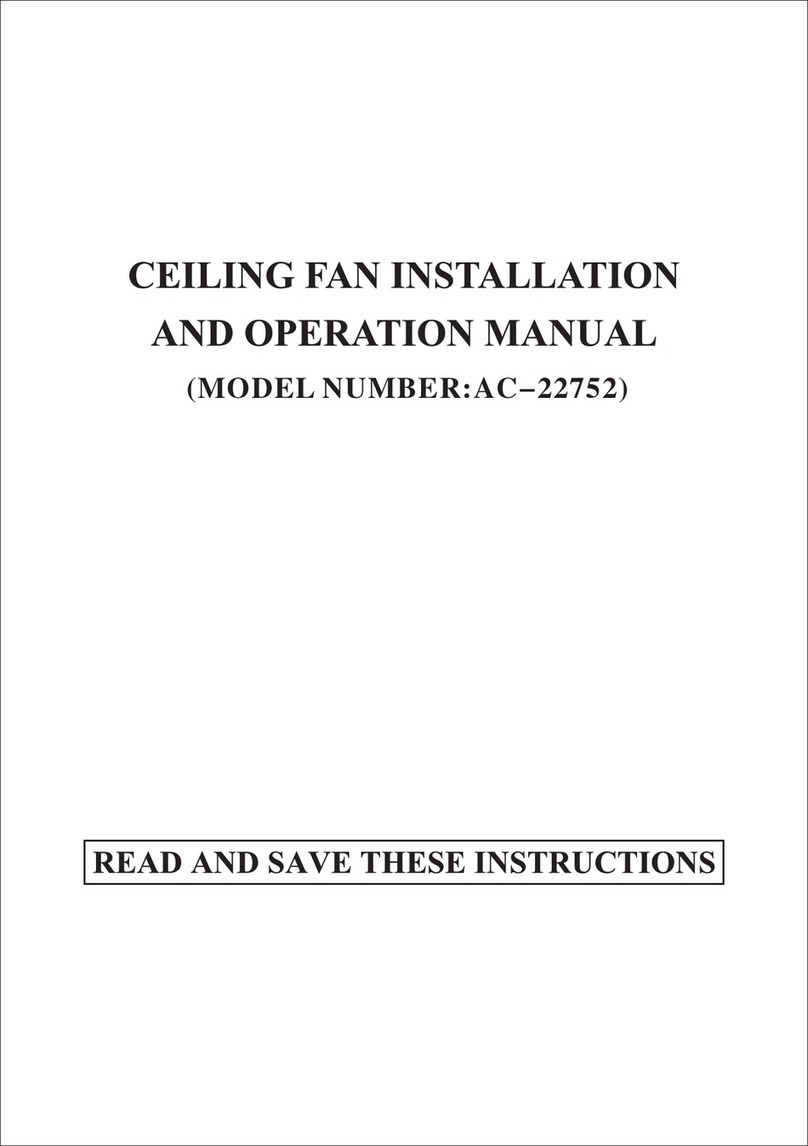
Kendal Lighting
Kendal Lighting Virtua Installation and operation manual
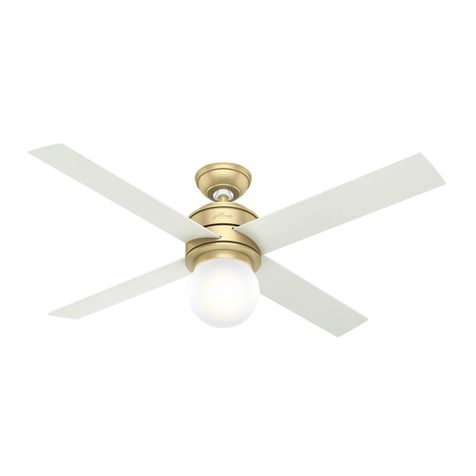
Hunter
Hunter Hepburn owner's manual
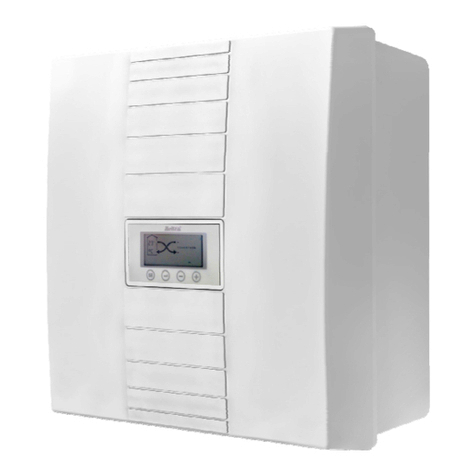
Meltem
Meltem M-WRG/ZNH-F user manual
